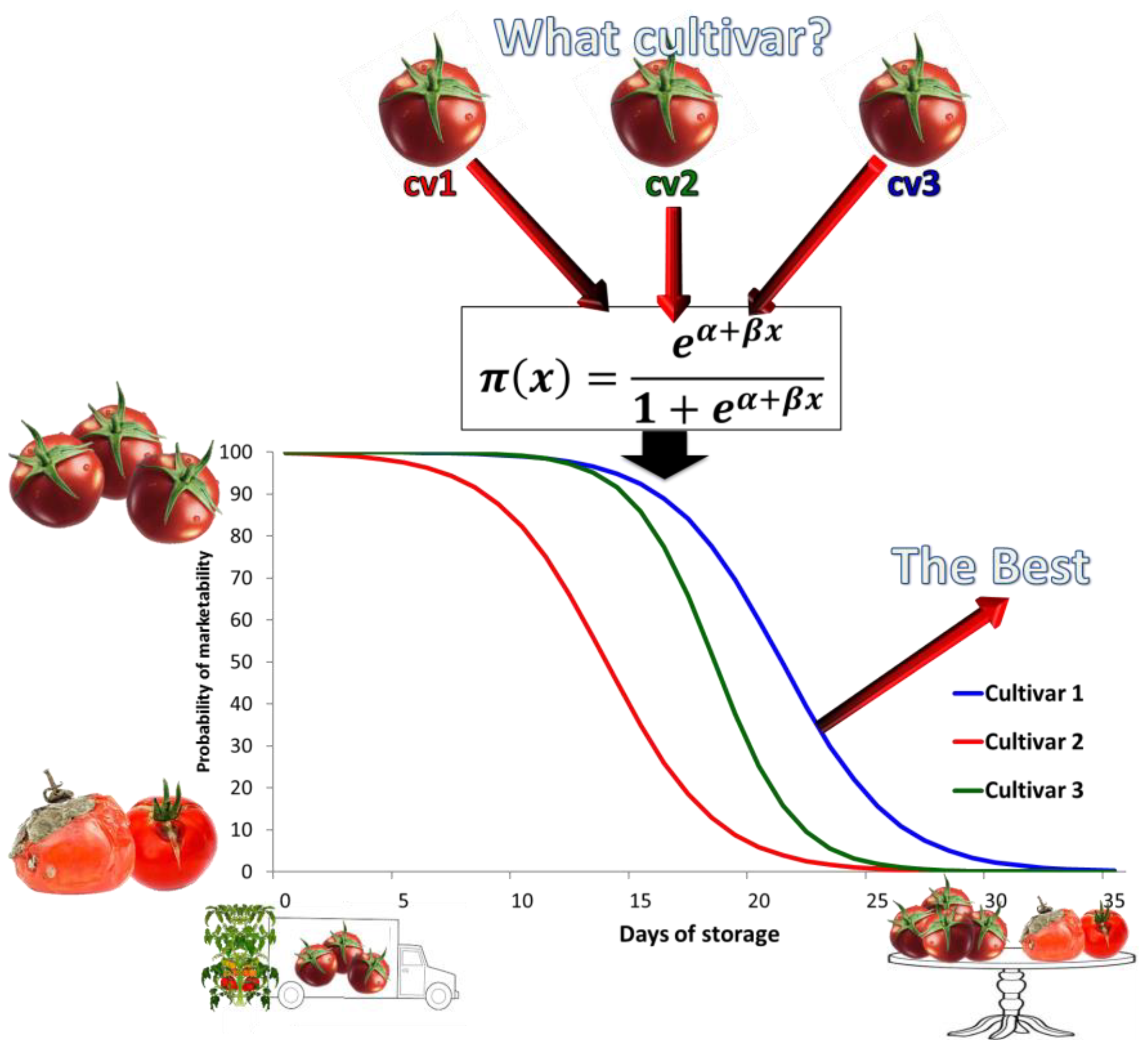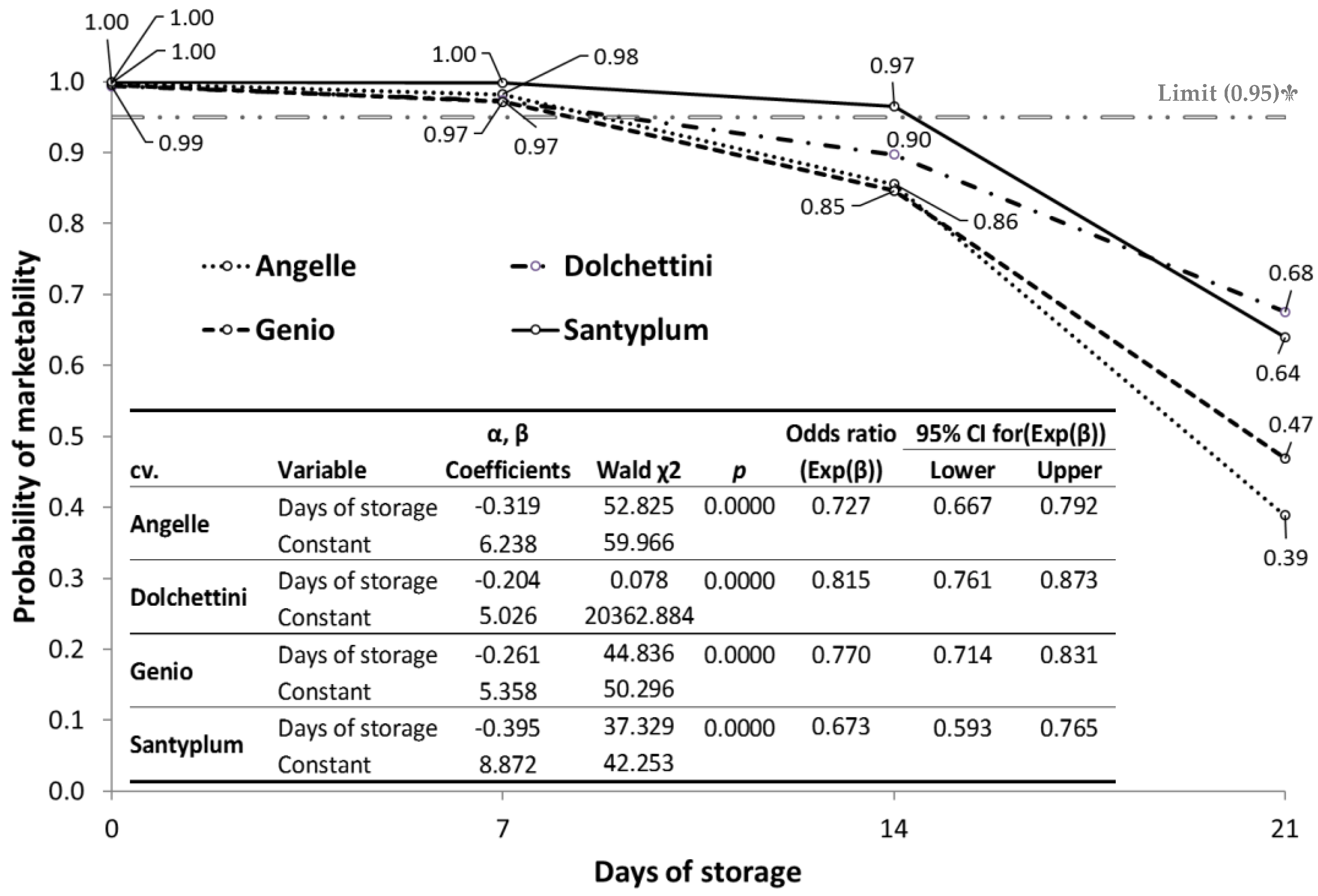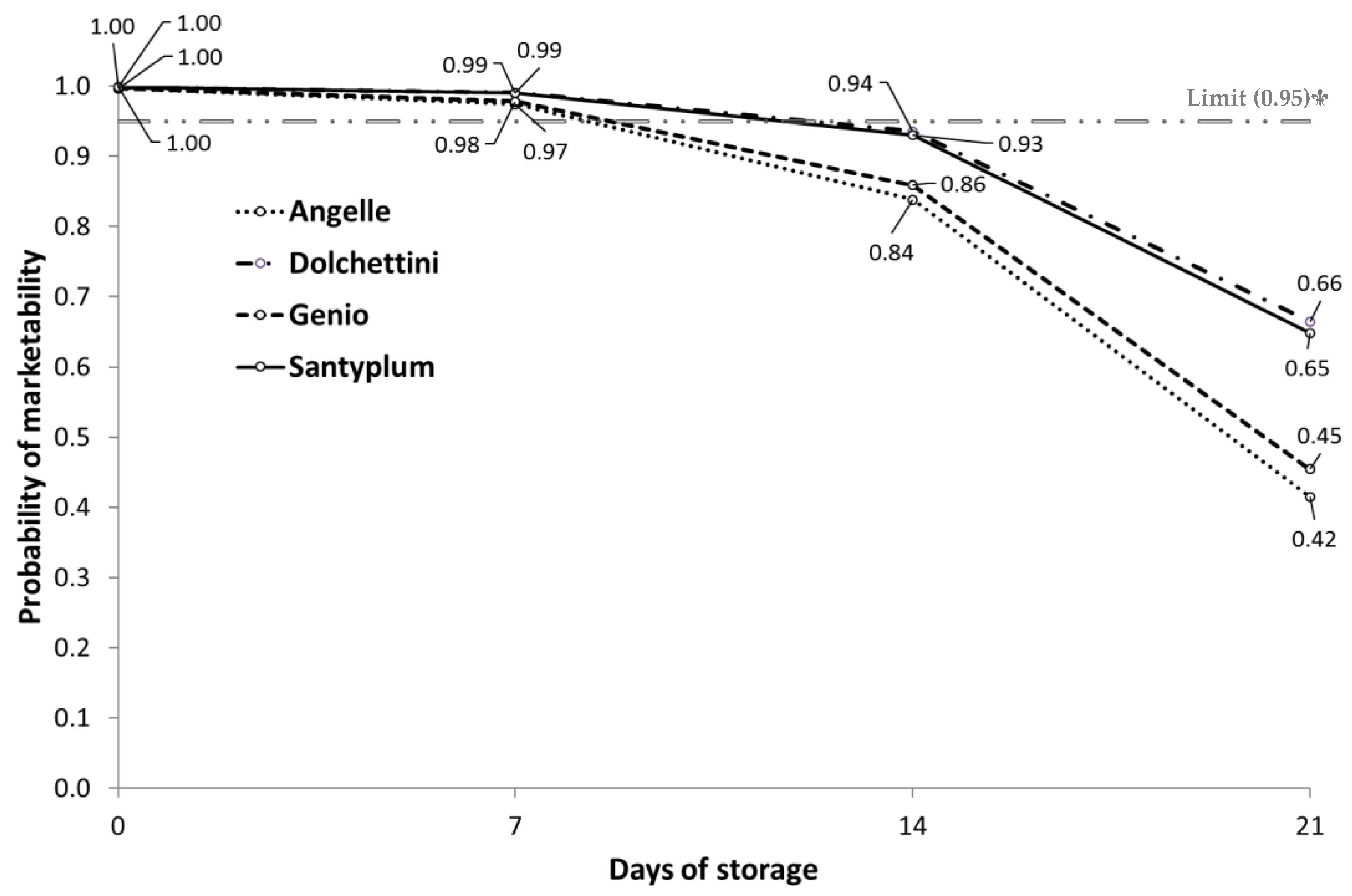Marketability Probability Study of Cherry Tomato Cultivars Based on Logistic Regression Models
Abstract
:1. Introduction
2. Materials and Methods
2.1. Production and Preparation of the Sampled Tomatoes
2.2. Experimental Design
- T0: At the time of collection, a subsample of 50 fruits from the initial 200 was randomly selected. The commercial quality was measured for each fruit (firmness, state of freshness, presence of fruit anomalies such as splitting, and fungi). The remaining 150 fruits were kept under storage conditions of 12 °C and 70% relative humidity for 7 days.
- T7: After 7 days under these storage conditions, a second subsample of 50 fruits was randomly extracted and evaluated for their commercial quality. The remaining 100 fruits were kept in a chamber at room temperature (18–20 °C), simulating the period of fruit exposure and sale to consumers.
- T14: After 7 days under market conditions (14 days after collection), of the remaining sample of 100 fruits, a third subsample of 50 fruits was randomly extracted, on which the commercial quality parameters were evaluated. The remaining 50 fruits were kept at room temperature (18–20 °C).
- T21: After 7 days (21 days after collection), the last subsample of 50 fruits was evaluated, on which the commercial quality parameters were measured.
2.3. Data Collection and Laboratory Measurements
2.4. Data Analysis
Logistic Regression
3. Results and Discussion
3.1. Influence of Days in Storage on the Marketability Probability Based on Simple Independent Logistic Regressions for Each Cultivar
3.2. Effects of the Cultivar and Days of Storage as Influencing Factors on the Marketability Probability
3.3. Effects of the Firmness and Cultivar as Influencing Factors on the Marketability Probability
3.4. Multiple Logistic Regression Model Fit Based on All the Studied Explanatory Variables
4. Conclusions
Author Contributions
Funding
Acknowledgments
Conflicts of Interest
References and Note
- Simonne, A.H.; Behe, B.K.; Marshall, M.M. Consumers prefer low-priced and high-lycopene-content fresh-market tomatoes. HortTechnology 2006, 4, 674–681. [Google Scholar]
- Toor, R.K.; Savage, G.P. Changes in major antioxidant components of tomatoes during postharvest storage. Food Chem. 2006, 99, 724–727. [Google Scholar] [CrossRef]
- Beckles, D.M. Factors affecting the postharvest soluble solids and sugar content of tomato (Solanum lycopersicum L.) fruit. Postharvest Biol. Technol. 2012, 1, 129–140. [Google Scholar] [CrossRef]
- Sibomana, M.S.; Ziena, L.W.; Schmidt, S. Influence of transportation conditions and postharvest disinfection treatments on microbiological quality of fresh market tomatoes (cv. Nemo-netta) in a South African supply chain. J. Food Protect. 2017, 2, 345–354. [Google Scholar] [CrossRef] [PubMed]
- Gustavsson, J.; Cederberg, C.; Sonesson, U.; Van Otterdijk, R. The Methodology of the FAO Study: “Global Food Losses and Food Waste—Extent, Causes and Prevention”—FAO, 2011. Available online: http://www.diva-portal.org/smash/get/diva2:944159/FULLTEXT01.pdf (accessed on 24 July 2018).
- Sibomana, M.S.; Workneh, T.S.; Audain, K. A review of postharvest handling and losses in the fresh tomato supply chain: A focus on sub-saharan Africa. Food Secur. 2016, 2, 389–404. [Google Scholar] [CrossRef]
- Macheka, L.; Spelt, E.J.; Bakker, E.J.; van der Vorst, J.G.; Luning, P.A. Identification of determinants of postharvest losses in Zimbabwean tomato supply chains as basis for dedicated interventions. Food Control 2018, 87, 135–144. [Google Scholar] [CrossRef]
- Buntong, B.; Srilaong, V.; Wasusri, T.; Kanlayanarat, S.; Acedo, A.L.J. Reducing postharvest losses of tomato in traditional and modern supply chains in Cambodia. Int. Food Res. J. 2013, 1, 233–238. [Google Scholar]
- Iotti, M.; Bonazzi, G. Analysis of the Risk of Bankruptcy of Tomato Processing Companies Operating in the Inter-Regional Interprofessional Organization “OI Pomodoro da Industria Nord Italia. Sustainability 2018, 10, 947. [Google Scholar] [CrossRef]
- Gamboa, G.; Kovacic, Z.; Di Masso, M.; Mingorría, S.; Gomiero, T.; Rivera-Ferré, M.; Giampietro, M. The Complexity of Food Systems: Defining Relevant Attributes and Indicators for the Evaluation of Food Supply Chains in Spain. Sustainability 2016, 8, 515. [Google Scholar] [CrossRef]
- Takeda, F.; Yang, W.; Li, C.; Freivalds, A.; Sung, K.; Xu, R.; Hu, B.; Williamson, J.; Sargent, S. Applying New Technologies to Transform Blueberry Harvesting. Agronomy 2017, 7, 33. [Google Scholar] [CrossRef]
- Prusky, D. Reduction of the incidence of postharvest quality losses, and future prospects. Food Secur. 2011, 4, 463–474. [Google Scholar] [CrossRef]
- Hoeberichts, F.A.; Linus, H.W.; Plas, V.D.; Woltering, E.J. Ethylene perception is required for the expression of tomato ripening-related genes and associated physiological changes even at advanced stages of ripening. Postharvest Biol. Technol. 2002, 26, 125–133. [Google Scholar] [CrossRef]
- Adams, M.R.; Hartley, A.D.; Cox, L.J. Factors affecting the efficacy of washing procedures used in the production of prepared salads. Food Microbiol. 1989, 6, 69–77. [Google Scholar] [CrossRef]
- Kader, A.A. Flavor quality of fruits and vegetables. J. Sci. Food. Agric. 2008, 11, 1863–1868. [Google Scholar] [CrossRef]
- Cantwell, M.; Nie, X.; Hong, G. Impact of storage conditions on grape tomato quality. In Proceedings of the 6th ISHS Postharvest Symposium, Antalya, Turkey, 8–12 April 2009. [Google Scholar]
- Kader, A.A. Effects of postharvest handling procedures on tomato quality. Acta Hortic. 1986, 190, 209–222. [Google Scholar] [CrossRef]
- Kader, A.A. Postharvest quality maintenance of fruits and vegetables in developing countries. In Postharvest Physiology and Crop Preservation; Lieberman, M., Ed.; Plenum Press: New York, NY, USA, 1983; pp. 455–470. [Google Scholar] [CrossRef]
- Tolesa, G.N.; Workneh, T.S.; Melesse, S.F. Logistic regression analysis of marketability of tomato fruit harvested at different maturity stages and subjected to disinfection, storage condition and storage period treatments. Biol. Agric. Hortic. 2017, 1, 40–52. [Google Scholar] [CrossRef]
- Melesse, S.; Sobratee, N.; Workneh, T.S. Application of logistic regression statistical technique to evaluate tomato quality subjected to different pre-and postharvest treatments. Biol. Agric. Hortic. 2016, 4, 277–287. [Google Scholar] [CrossRef]
- Tzortzakis, N.G.; Borland, A.; Singleton, I.; Barnes, J. Impact of atmospheric ozone-enrichment on quality-related attributes of tomato fruit. Postharvest Biol. Technol. 2007, 45, 317–325. [Google Scholar] [CrossRef]
- Lurie, S. Postharvest heat treatments. Postharvest Biol. Technol. 1998, 3, 257–269. [Google Scholar] [CrossRef]
- Paull, R.E.; Chen, N.J. Heat treatment and fruit ripening. Postharvest Biol. Technol. 2000, 1, 21–37. [Google Scholar] [CrossRef]
- Kader, A.A. Increasing food availability by reducing postharvest losses of fresh produce. Acta Hortic. V Int. Postharvest Symp. 2005, 682, 2169–2176. [Google Scholar] [CrossRef]
- Sudheer, K.P.; Indira, V. Postharvest Technology of Horticultural Crops; New India Publishing Agency: New Delhi, India, 2007; p. 291. ISBN 818942243X. [Google Scholar]
- Faize, L.; Faize, M. Functional Analogues of Salicylic Acid and Their Use in Crop Protection. Agronomy 2018, 8, 5. [Google Scholar] [CrossRef]
- Adiletta, G.; Pasquariello, M.; Zampella, L.; Mastrobuoni, F.; Scortichini, M.; Petriccione, M. Chitosan Coating: A Postharvest Treatment to Delay Oxidative Stress in Loquat Fruits during Cold Storage. Agronomy 2018, 8, 54. [Google Scholar] [CrossRef]
- Polderdijk, J.J.; Tijskens, L.M.M.; Robbers, J.E.; van der Valk, H.C.P.M. Predictive model of keeping quality of tomatoes. Postharvest Biol. Technol. 1993, 2, 179–185. [Google Scholar] [CrossRef]
- Kader, A.A.; Morris, L.L.; Stevens, M.A.; Holton, M.A. Composition and flavor quality of fresh market tomatoes as influenced by some postharvest handling procedures. J. Am. Horti. Sci. 1978, 1, 6–13. [Google Scholar]
- Sirisomboon, P.; Tanaka, M.; Kojima, T.; Williams, P. Nondestructive estimation of maturity and textural properties on tomato ‘Momotaro’ by near infrared spectroscopy. J. Food Eng. 2012, 3, 218–226. [Google Scholar] [CrossRef]
- Sirisomboon, P.; Tanaka, M.; Kojima, T. Evaluation of tomato textural mechanical properties. J. Food Eng. 2012, 4, 618–624. [Google Scholar] [CrossRef]
- Hosmer, D.W.; Lemeshow, S.; Sturdivant, R.X. Applied Logistic Regression; John Wiley & Sons: Hoboken, NJ, USA, 2013; Volume 398, p. 500. ISBN 978-0-470-58247-3. [Google Scholar]
- Lammertyn, J.; Aerts, M.; Verlinden, B.E.; Schotsmans, W.; Nicolaı, B.M. Logistic regression analysis of factors influencing core breakdown in ‘Conference’ pears. Postharvest Biol. Technol. 2000, 1, 25–37. [Google Scholar] [CrossRef]
- Valero, D.; Serrano, M. Postharvest Biology and Technology for Preserving Fruit Quality; CRC Press, Taylor & Francis Group: New York, NY, USA, 2010; p. 217. ISBN 978-1-4398-0266-3. [Google Scholar]
- Collett, D.R. Modelling Binary Data, 2nd ed.; Chapman and Hall: London, UK, 2002; p. 408. ISBN 9871420057386. [Google Scholar]
- Agresti, A. An Introduction to Categorical Data Analysis, 2nd ed.; John Wiley & Sons: Hoboken, NJ, USA, 1996; p. 372. ISBN 978-0-471-22618-5. [Google Scholar]
- Rothman, K.J.; Greenland, S.; Lash, T.L. Modern epidemiology, 3rd ed.; Lippincott Williams & Wilkins: Philadelphia, PA, USA, 2008; p. 758. ISBN 9781451190052. [Google Scholar]
- Commission Implementing Regulation (EU) No 543/2011 of 7 June 2011. Laying down detailed rules for the application of Council Regulation (EC) No 1234/2007 in respect of the fruit and vegetables and processed fruit and vegetables sectors
- Fagundes, C.; Moraes, K.; Pérez-Gago, M.B.; Palou, L.; Maraschin, M.; Monteiro, A.R. Effect of active modified atmosphere and cold storage on the postharvest quality of cherry tomatoes. Postharvest Biol. Technol. 2015, 109, 73–81. [Google Scholar] [CrossRef]
- Van linden, V.; De Ketelaere, B.; Desmet, M.; De Baerdemaeker, J. Determination of bruise susceptibility of tomato fruit by means of an instrumented pendulum. Postharvest Biol. Technol. 2006, 1, 7–14. [Google Scholar] [CrossRef]
- Dixon, J.; Pak, H.A.; Smith, D.B.; Elmsly, T.A. New Zealand avocado fruit quality: The impact of storage temperatura and maturity. In Proceedings of the V World Avocado Congress, Granada and Málaga, Spain, 19–24 October 2003. [Google Scholar]
- Ailes, E.C.; Leon, J.S.; Jaykus, J.L.M.; Clayton, H.A.; Blanding, S.; Kleinbaum, D.G.; Backer, L.C.; Moe, C.L. Microbial concentrations on fresh produce are affected by postharvest processing, importation, and season. J. Food Prot. 2008, 71, 2389–2397. [Google Scholar] [CrossRef] [PubMed]
- Vanstreels, E.; Lammertyn, J.; Verlinden, B.E.; Gillis, N.; Schenk, A.; Nicolai, B.M. Red discoloration of chicory under controlled atmosphere conditions. Postharvest Biol. Technol. 2002, 3, 313–322. [Google Scholar] [CrossRef]




| Variables | α, β Coefficients a | Wald χ2 | p | Odds Ratio (Exp (β)) | 95% CI for | (Exp(β)) b |
|---|---|---|---|---|---|---|
| Lower | Upper | |||||
| Constant | 6.573 | 185.705 | <0.000 | 715.527 | ||
| DOS | −0.284 | 170.626 | <0.000 | 0.753 | 0.722 | 0.786 |
| ‘Angelle’ | −0.952 | 11.435 | 0.001 | 0.386 | 0.222 | 0.670 |
| ‘Genio’ | −0.793 | 6.772 | 0.009 | 0.452 | 0.249 | 0.822 |
| ‘Dolchettini’ | 0.075 | 0.056 | 0.813 | 1.078 | 0.580 | 2.002 |
| ‘Santyplum’ | Reference | |||||
| Constant | 6.648 | 164.583 | <0.000 | 771.114 | ||
| DOS | −0.284 | 170.626 | <0.000 | 0.753 | 0.722 | 0.786 |
| ‘Santyplum’ | −0.075 | 0.056 | 0.813 | 0.928 | 0.499 | 1.724 |
| ‘Angelle’ | −1.027 | 10.298 | 0.001 | 0.358 | 0.191 | 0.671 |
| ‘Genio’ | −0.868 | 6.547 | 0.011 | 0.420 | 0.216 | 0.816 |
| ‘Dolchettini’ | Reference | |||||
| Constant | 5.780 | 152.953 | <0.000 | 323.679 | ||
| DOS | −0.284 | 170.626 | <0.000 | 0.753 | 0.722 | 0.786 |
| ‘Dolchettini’ | 0.868 | 6.547 | 0.011 | 2.382 | 1.225 | 4.632 |
| ‘Santyplum’ | 0.793 | 6.772 | 0.009 | 2.211 | 1.216 | 4.018 |
| ‘Angelle’ | −0.158 | 0.281 | 0.596 | 0.853 | 0.475 | 1.534 |
| ‘Genio’ | Reference | |||||
| Constant | 5.621 | 175.057 | <0.000 | 276.251 | ||
| DOS | −0.284 | 170.626 | <0.000 | 0.753 | 0.722 | 0.786 |
| ‘Genio’ | 0.158 | 0.281 | 0.596 | 1.172 | 0.652 | 2.106 |
| ‘Dolchettini’ | 1.027 | 10.298 | 0.001 | 2.791 | 1.491 | 5.225 |
| ‘Santyplum’ | 0.952 | 11.435 | 0.001 | 2.590 | 1.492 | 4.497 |
| ‘Angelle’ | Reference |
| Variables | α, β Coefficients a | Wald χ2 | p | Odds Ratio (Exp (β)) | 95% CI for | (Exp(β)) b |
|---|---|---|---|---|---|---|
| Lower | Upper | |||||
| Constant | −63.724 | 58.665 | 0 | 0 | ||
| Firmness (%) | 0.963 | 59.548 | 0.000 | 2.620 | 2.052 | 3.347 |
| ‘Angelle’ | 2.429 | 10.990 | 0.001 | 11.343 | 2.699 | 47.678 |
| ‘Genio’ | 2.776 | 12.547 | 0.000 | 16.055 | 3.456 | 74.592 |
| ‘Dolchettini’ | 1.589 | 4.074 | 0.044 | 4.898 | 1.047 | 22.911 |
| ‘Santyplum’ | Reference | |||||
| Constant | −62.135 | 58.153 | 0.000 | 0.000 | ||
| Firmness (%) | 0.963 | 59.548 | 0.000 | 2.620 | 2.052 | 3.347 |
| ‘Santyplum’ | −1.589 | 4.074 | 0.044 | 0.204 | 0.044 | 0.955 |
| ‘Angelle’ | 0.840 | 1.376 | 0.241 | 2.316 | 0.569 | 9.423 |
| ‘Genio’ | 1.187 | 2.417 | 0.120 | 3.278 | 0.734 | 14.643 |
| ‘Dolchettini’ | Reference | |||||
| Constant | −60.948 | 58.850 | 0.000 | 0.000 | ||
| Firmness (%) | 0.963 | 59.548 | 0.000 | 2.620 | 2.052 | 3.347 |
| ‘Dolchettini’ | −1.187 | 2.417 | 0.120 | 0.305 | 0.068 | 1.363 |
| ‘Santyplum’ | −2.776 | 12.547 | 0.000 | 0.062 | 0.013 | 0.289 |
| ‘Angelle’ | −0.347 | 0.328 | 0.567 | 0.707 | 0.215 | 2.322 |
| ‘Genio’ | Reference | |||||
| Constant | −61.295 | 59.285 | 0.000 | 0.000 | ||
| Firmness (%) | 0.963 | 59.548 | 0.000 | 2.620 | 2.052 | 3.347 |
| ‘Genio’ | 0.347 | 0.328 | 0.567 | 1.415 | 0.431 | 4.651 |
| ‘Dolchettini’ | −0.840 | 1.376 | 0.241 | 0.432 | 0.106 | 1.757 |
| ‘Santyplum’ | −2.429 | 10.990 | 0.001 | 0.088 | 0.021 | 0.371 |
| ‘Angelle’ | Reference |
| Variables | α, β Coefficients | Wald χ2 | p | Odds Ratio (Exp (β)) | 95% CI for | (Exp(β)) |
|---|---|---|---|---|---|---|
| Lower | Upper | |||||
| November | 4.321 | 14.895 | <0.000 | 75.239 | 8.385 | 675.095 |
| December | 4.834 | 17.994 | <0.000 | 125.759 | 13.473 | 1173.857 |
| January | 2.510 | 7.6980 | 0.006 | 12.309 | 2.090 | 72.509 |
| DOS c | −0.124 | 5.639 | 0.018 | 0.883 | 0.797 | 0.979 |
| Firmness | 1.102 | 45.149 | <0.000 | 3.011 | 2.183 | 4.154 |
| Constant | −71.750 | 43.388 | <0.000 | ≈ 0 |
© 2018 by the authors. Licensee MDPI, Basel, Switzerland. This article is an open access article distributed under the terms and conditions of the Creative Commons Attribution (CC BY) license (http://creativecommons.org/licenses/by/4.0/).
Share and Cite
Díaz-Pérez, M.; Carreño-Ortega, Á.; Gómez-Galán, M.; Callejón-Ferre, Á.-J. Marketability Probability Study of Cherry Tomato Cultivars Based on Logistic Regression Models. Agronomy 2018, 8, 176. https://doi.org/10.3390/agronomy8090176
Díaz-Pérez M, Carreño-Ortega Á, Gómez-Galán M, Callejón-Ferre Á-J. Marketability Probability Study of Cherry Tomato Cultivars Based on Logistic Regression Models. Agronomy. 2018; 8(9):176. https://doi.org/10.3390/agronomy8090176
Chicago/Turabian StyleDíaz-Pérez, Manuel, Ángel Carreño-Ortega, Marta Gómez-Galán, and Ángel-Jesús Callejón-Ferre. 2018. "Marketability Probability Study of Cherry Tomato Cultivars Based on Logistic Regression Models" Agronomy 8, no. 9: 176. https://doi.org/10.3390/agronomy8090176





